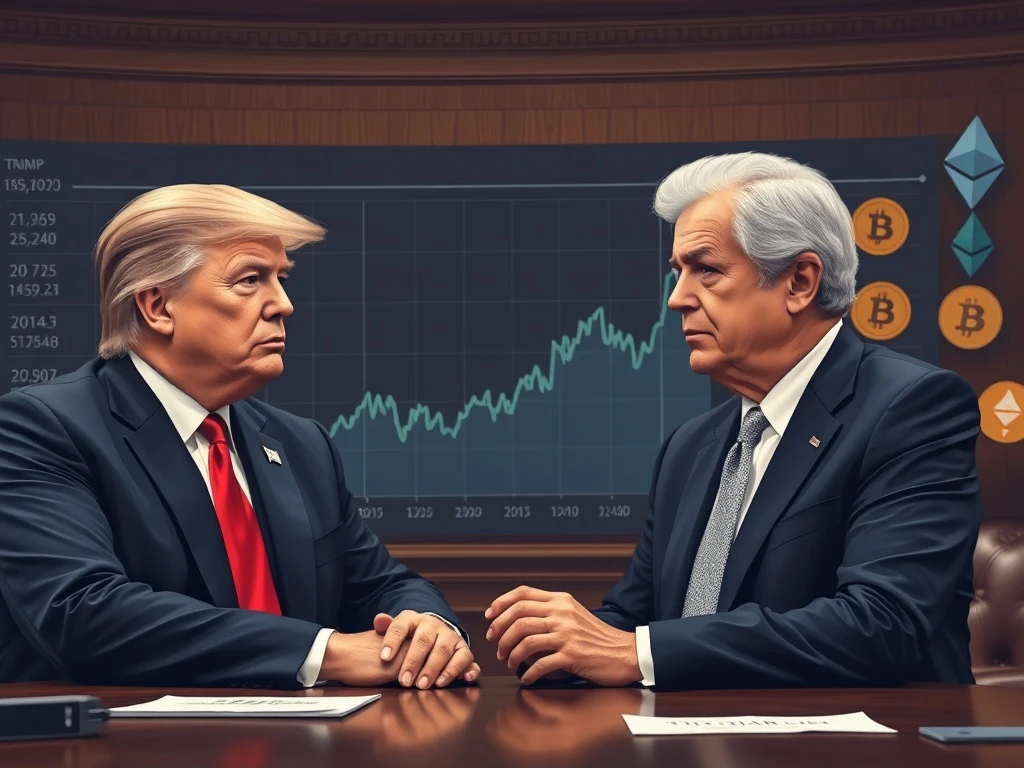Trump Rate Cuts: Urgent Pressure Unleashed on Powell, Shaking Crypto Markets

The financial world is buzzing following a high-stakes encounter between former President Donald Trump and Federal Reserve Chair Jerome Powell. This isn’t just a political spectacle; it’s a pivotal moment that could dramatically influence the global economy, the housing market, and, critically for our readers, the dynamic crypto market. The core of the tension? Trump’s relentless push for significant Trump rate cuts, a move he believes is essential for economic stimulation. But what does this mean for Bitcoin, Ethereum, and your digital assets?
Trump Rate Cuts: The Pressure Mounts on the Fed
On July 24, 2025, President Donald Trump made a rare visit to the Federal Reserve’s headquarters, turning a tour of its renovation project into a public platform for his economic agenda. During the visit, Trump directly urged Federal Reserve Chair Jerome Powell to lower US interest rates, emphasizing the potential benefits for economic growth and housing affordability. “I’d love him to lower interest rates,” Trump stated, advocating for policies that would make homebuying more attractive and stimulate the broader economy.
This public pressure underscores months of underlying tension between the White House and the central bank. Trump has historically accused Powell of maintaining high rates for “political reasons” and even scrutinized the costs of the Fed’s renovation project. While Powell maintained a neutral demeanor during the exchange, the message from the President was clear: he wants more accommodative monetary policy.
Federal Reserve Policy: Independence Under Scrutiny
The independence of the Federal Reserve policy is a cornerstone of its mandate, designed to shield it from political influence and allow it to make decisions based solely on economic data. However, Trump’s persistent calls for rate cuts, including past suggestions of firing Powell, have put this independence under intense scrutiny. While the President later dismissed the idea of firing Powell as “highly unlikely,” the public nature of his demands raises questions about the central bank’s autonomy.
The visit also brought renewed attention to the Fed’s $2.5 billion renovation project, which Trump publicly criticized for cost overruns. Powell, in a rare public correction, clarified that the President had conflated expenses from a completed initiative. Despite these political critiques, the Fed maintains that delays and cost increases are due to unforeseen external factors, not mismanagement. Analysts warn that such public pressure risks undermining the institution’s credibility, yet the Fed’s historical resilience suggests it is unlikely to capitulate to direct presidential demands.
Jerome Powell’s Stance and Economic Indicators
Amidst the political clamor, Jerome Powell has consistently reiterated the Federal Reserve’s commitment to its independence and its data-dependent approach to monetary policy. His term as chair extends until May 2026, providing a degree of stability in leadership. The Fed’s stance remains cautious, with officials signaling that any future policy decisions, including potential rate adjustments, will be contingent on evolving economic indicators.
The upcoming July 29–30 policy meeting is anticipated as a potential inflection point. Market participants will be closely watching for any signals regarding the Fed’s outlook on inflation, employment, and overall economic health. Powell’s measured responses to Trump’s demands highlight the delicate balance the central bank must strike between political pressures and its mandate to ensure price stability and maximum employment.
How US Interest Rates Influence the Crypto Market Impact
The interplay between US interest rates and the crypto market impact is a significant factor for digital asset investors. Historically, lower U.S. yields tend to correlate with rising cryptocurrency prices, as investors seek higher returns in alternative, riskier assets. When traditional investments offer lower returns due to reduced interest rates, capital often flows into more speculative markets like crypto.
Here’s how lower interest rates could influence the crypto space:
- Increased Liquidity: Accommodative monetary policy generally leads to more money circulating in the financial system, which can find its way into crypto markets.
- Search for Yield: With lower returns on savings accounts and bonds, investors may turn to high-growth potential assets like Bitcoin (BTC), Ether (ETH), Solana (SOL), and Avalanche (AVAX).
- Inflation Hedge Narrative: While not universally accepted, some investors view Bitcoin as a potential hedge against inflation, which could be a concern if aggressive rate cuts lead to an overheating economy.
Despite these potential tailwinds, it’s crucial to remember that no official rate cut has been announced. The crypto market, while influenced by macroeconomics, also has its own unique drivers and volatility.
Navigating Market Volatility and Future Outlook
As the 2026 election approaches, the dynamic between political pressures and the Fed’s data-driven approach will remain a focal point. Trump’s calls for Trump rate cuts reflect his emphasis on short-term economic growth, aiming to bolster sectors like housing and potentially fuel a pre-election boom. Conversely, the Fed’s cautious stance underscores its broader mandate to balance inflation control with employment stability, looking beyond immediate political cycles.
For investors, particularly in the crypto market, this ongoing tension translates into potential volatility. Understanding the nuances of this relationship is key to navigating the coming months. While presidential influence is undeniable, the Federal Reserve’s institutional independence and historical resilience suggest it will continue to prioritize its long-term economic objectives. The outcome of this high-stakes dynamic will undoubtedly shape broader market sentiment and policy expectations.
Conclusion
The recent exchange between Donald Trump and Jerome Powell highlights a persistent tension between political desires for rapid economic stimulation and the Federal Reserve’s commitment to independent, data-driven monetary policy. Trump’s push for Trump rate cuts has clear implications for the housing market and the broader economy, with a significant ripple effect anticipated in the crypto market impact. While Jerome Powell and the Federal Reserve policy aim to maintain stability, the ongoing dialogue around US interest rates will continue to be a dominant narrative, shaping investment decisions and economic outlooks in the months to come.
Frequently Asked Questions (FAQs)
Q1: Why is Donald Trump pushing for rate cuts?
Donald Trump is advocating for rate cuts primarily to stimulate economic growth and boost the housing market. He believes lower interest rates will make homebuying more affordable and encourage business investment, aligning with his broader economic agenda.
Q2: How do interest rate cuts typically affect the crypto market?
Historically, lower US interest rates tend to make traditional investments less attractive, leading investors to seek higher returns in alternative assets like cryptocurrencies. This can increase liquidity and demand in the crypto market, potentially boosting prices for assets like Bitcoin, Ethereum, and Solana.
Q3: Can the President force the Federal Reserve to cut rates?
No, the President cannot directly force the Federal Reserve to cut rates. The Fed operates with a mandate of independence from political influence to ensure its decisions are based on economic data rather than political expediency. While a president can exert public pressure, the Fed Chair and its governors make policy decisions independently.
Q4: What is Jerome Powell’s stance on Trump’s demands?
Jerome Powell has maintained a neutral and data-dependent stance. He has reiterated the Federal Reserve’s commitment to its independence and has indicated that any policy decisions, including rate adjustments, will be based on evolving economic indicators and the Fed’s dual mandate of stable prices and maximum employment.
Q5: What is the significance of the Federal Reserve’s renovation project?
The Federal Reserve’s renovation project became a point of contention due to its cost and delays, drawing public criticism from Donald Trump. While the project itself is operational, its expenses and management became a symbolic point of scrutiny in the broader political debate over government spending and accountability.






